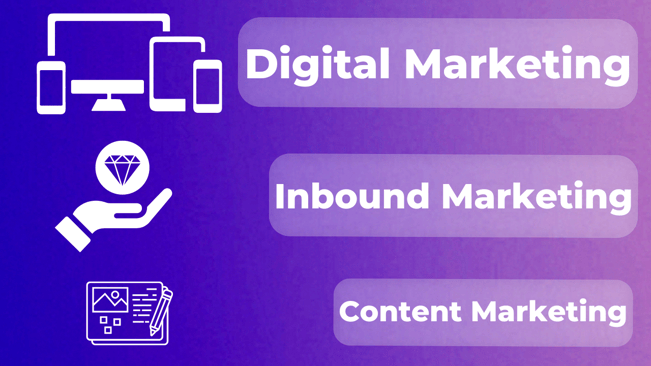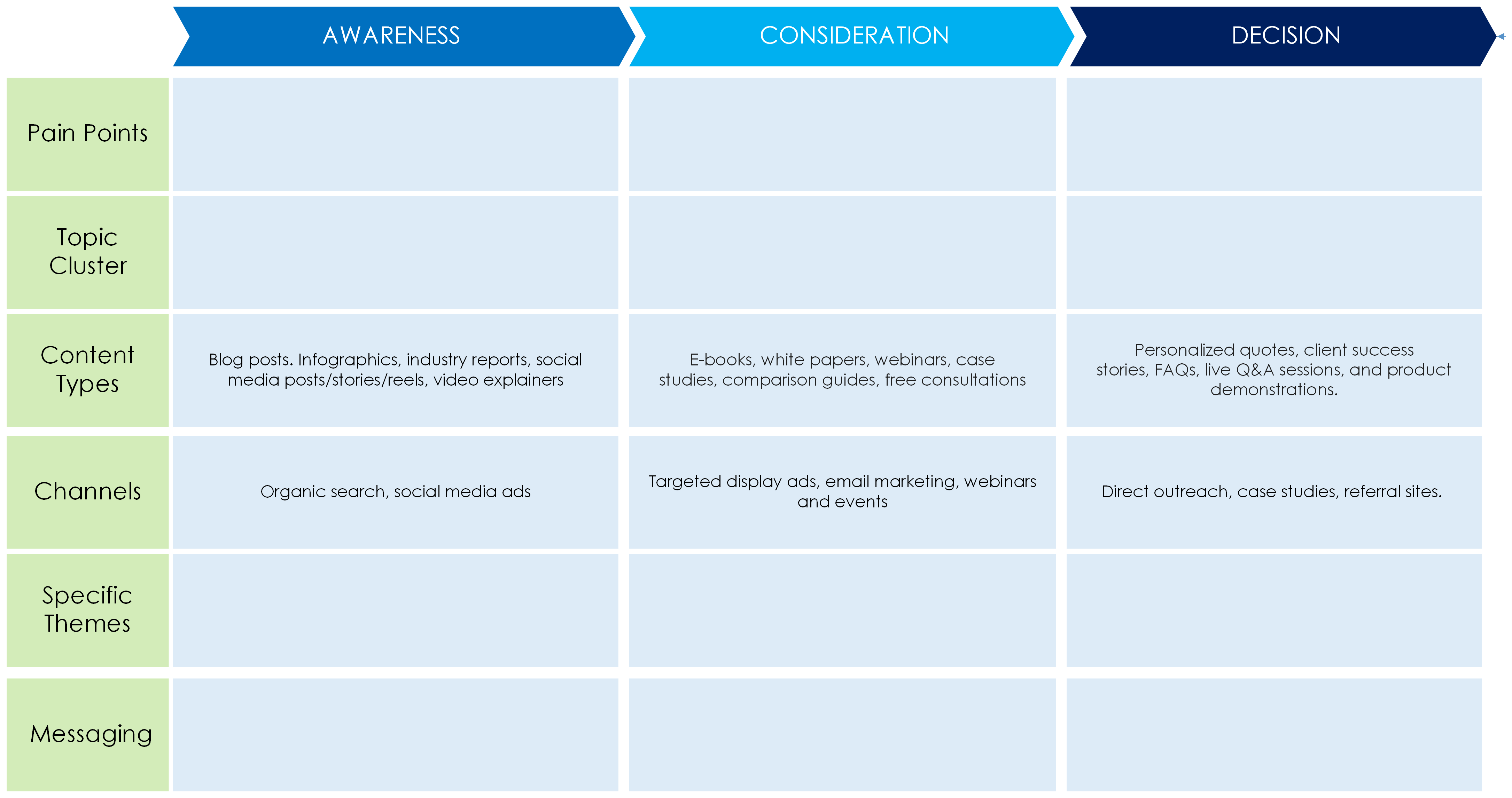Digital Marketing Demystified - Part 1: The Role of Content Marketing
Marketing today can sometimes feel like shouting into a black hole.
Competition for customers’ attention is fierce, making it hard to stand out. Complicating matters, consumer preferences are constantly changing, meaning brands must act fast. Businesses have to navigate the complex digital marketing landscape to engage with their target audience when promoting across platforms.
Digital marketing, the overarching strategy encompassing all marketing efforts using digital channels, is how modern businesses communicate with their target audience. Within digital marketing is inbound marketing, a specific approach that focuses on attracting customers through valuable content and meaningful interactions. Content marketing is a subset of digital and inbound marketing, which focuses on creating and sharing valuable content with your audience to drive meaningful action. 
Digital marketing sometimes overlaps with traditional marketing channels like TV and radio, blurring the lines between the two and creating confusion around what counts as digital marketing.
The term itself contributes to the confusion. Being so broad and rooted in technological advancement, it sounds more complex than it is. This can drive brands away from wanting to invest in digital marketing strategies fully. It doesn’t have to.
There are a lot of ways to make digital marketing seem less scary. The first step is educating yourself on what it is. But that doesn’t have to be hard (and you’ve already learned a little), so just keep reading and we’ll do the heavy lifting.
What is Content Marketing?
Content marketing is a strategic inbound approach focused on creating and distributing valuable, relevant, consistent content to attract and keep a clearly defined audience. Content marketers want to drive profitable action by providing their audiences with helpful information that addresses a need or a value.
Unlike traditional advertising approaches that send quick messages to a large audience, content marketing is rooted in delivering value-driven material. Instead of directly promoting a product or service, content marketing works to educate and entertain audiences who engage with it over time. This approach builds trust, driving people to act in favor of your brand. You make valuable content, and people enjoy it! That’s a win-win.
Why Content Marketing Matters
Shouting an advertisement across popular radio stations used to grow revenue significantly. It doesn’t anymore. Why not? There is too much noise.
Brands of all sizes are competing for the attention of audiences. As more competition crowds the market, brands will have to rely on creating informative content and distributing it effectively to their target audiences. On top of boosting brand awareness, consistently providing your audiences with valuable content will set up your brand as a leader in your industry. Why is leadership important? Even for small businesses, a strong online presence and brand voice will lead to success over time.
This long-term thinking is at the core of content marketing. Brands that establish strong connections with their audience will be rewarded with loyal customers who are more likely to engage with the brand, advocate for it, and make repeat purchases. These connections can lead to increased trust in the brand, stronger customer relationships, and a positive brand reputation.
Creating Content
Now that you understand the power of content marketing, you can begin diving into the many kinds of content at your creative disposal. It’s important to note that several types of content formats attract different audiences, so learning which will resonate most with your audience is essential to reaching them.
Short-form content is, as it sounds, short! Short-form content is easily digestible and efficiently delivers a concise message to your audience. From infographics to short testimonial videos, there’s a ton of short-form content to create.“5 Quick Tips” or summaries of longer discussions offer an easily accessible, bite-sized piece of content to attract and engage audiences across many. Capturing audience attention visually appealingly – short-form content usually sticks to surface-level topics that provide audiences with a basic understanding of a topic.
.png?width=1280&height=720&name=Heading%20(2).png)
Long-form content is your friend for providing in-depth analysis and storytelling. The allotment of more space, whether a detailed product demo, case study, or eBook, allows for a narrative-driven analysis that provides insights into the topic. Less flashy and engaging, long-form content relies on detailed explanations and attractive formatting to keep the audience’s attention over a sustained period.
Before you press “post,” there are a few steps you should take to ensure that you’re making impactful content that your audiences will want to see. How do you do that? It’s all in the strategy.
Develop a Content Marketing Strategy
The first step every content creator should take in their strategy is analyzing where their audience is and, more importantly, WHO their audience is. You can find this by creating these buyer personas (or fictional representations of your ideal customers) based on your market research and existing data.
What kind of data? Things like demographics, interests, challenges, and purchasing behavior. You can collect this information by conducting surveys or doing market research, using it to create detailed personas that represent different segments of your target audience. You can choose specific channels and content formats to reach certain audiences, increasing leads and strengthening brand loyalty.
It’s important to target specific segments of your audience and stages of the buyer’s journey. Need a refresher on the buyer’s journey? It’s broken up into three sections. Think of them as the steps you take when making a purchase. Starting at the awareness stage, transitioning into the consideration stage, before funneling into the decision-making stage where you either press "purchase" or close the browser. Understanding where your target audience is in these stages is crucial in delivering content that will meet their specific needs.
Once you’ve established the three points in the buyer’s journey, you can start addressing specific pain points and messaging strategies. Not all types of content will speak to every stage of the journey. Collect information on where your viewers typically view you and engage with your content.
An example is when creating content for the awareness stage, you’ll want to focus on creating content that entertains and engages people to learn more about what you offer. Short blog posts, social media stories/reels, and infographics are all great ways of appealing to people just learning about your brand.
More of a visual learner? Don’t worry, we’ve got you covered. 
We filled in some of it for you (you’re welcome); now, just fill in the rest and use it to guide your content strategy. You’ll be unstoppable!
Another important note is to set measurable objectives. The sky's the limit, but you won’t want to set completely out-of-this-world goals. Confirming that your goals are Specific, Measurable, Achievable, Relevant, and Time-bound is key to staying on the right track. Someone should make a catchy acronym to remember that...
Knowing who and how you reach them is the one-two punch that drives any successful content distribution strategy. Once you have that, you can make content that speaks directly to them and promote it on various platforms. Want some real-life examples?
Content Marketing In Action
Sometimes, a simple hashtag can bring a mountain of successful content. Once a week, Canva hosts the #canvadesignchallenge, issuing a challenge around a topic or a feature on their platform.
Platforming the best design each week to boost engagement and community, while also using the challenge as an opportunity to educate the public on lesser-known features of the tool is extremely powerful. 10 winners each week are awarded a year-long subscription to Canva Pro and a $50 voucher for Canva Print, a valuable reward. Promoted on their socials, the designs promote the platform as well as acting as engaging content for people who are already longtime followers of the brand. With themes like designing a playlist cover or holiday postcard, they allow designers of all skill levels to get creative and push the platform to new limits.
An example a little bit closer to home, Team Trailblaze got to show our content marketing chops when we took a business from $0 to $900,000 in online sales in under 3 years. One way we did that was by going all-in on our content marketing. Where Amazon pages don't carry much authority, we leveraged share-worthy content that bumped traffic back to the product and category pages.
Writing everything there is to know about the client's product, we saw organic growth of 221% AND established our client as a leader in their field. That's the best of both worlds if we've ever seen it! We then used the good reviews from that growth to provide even more credibility for the products and brand.
So you've seen how other people have leveraged content marketing and you know all the greatness it holds - but how are you supposed to know how well your content is doing? That's when you measure it.
Clicks and Conversations: Measuring Success
Once your content is posted, it’s time to track your success. Providing you with valuable insights on a wide range of information, learning the different ways to track success will help you get smarter over time. How do you know what key metrics to use to track success? Just keep reading.
The first way is to monitor website traffic. Website traffic means a whole bunch of things. From page views, the time spent on each page, or conversion rates, there's a lot to look at and it can all be insightful! If you can see where your viewers are spending the most time on your website, you can use that information to drive future decisions surrounding your online presence.
Measuring the percentage of website visitors who complete a desired action (like making a purchase) allows you to see how successful your website is. Analyze which campaigns have a high conversion rate and which need some more love.
Besides your website, you can engage with your audience via social media channels. You’ll want to engage with each social platform in different ways, optimizing your strategy to fit the guidelines and trends. Within different social platforms, you can gauge brand awareness and build a strong sense of community within your brand. Measuring content marketing metrics is crucial for understanding the effectiveness of your efforts, ultimately impacting your return on investment (how profitable your marketing strategy is). If you’re seeing positive ROI around a campaign, it’s generating more revenue than it costs. Calculating the ROI of your marketing campaigns will identify which are the most effective and which need help improving their strategy.
What's Next?
We've shown you what content marketing is, why it's important, and how you can go about creating content that drives traffic to your brand. Your job now is to try your best to create content that speaks to a specific need, promote it across various platforms and channels, and then study the success to optimize for the future.
Have any specific questions you need answered? Shoot us a message, we're here to help.







